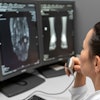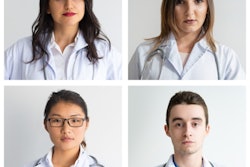International medical graduates (IMGs) appear to face difficulties getting visas for employment in U.S. academic radiology departments, according to a recent study by researchers at John Hopkins Medicine in Baltimore, MD.
Ultimately, overcoming these barriers could help alleviate workforce shortages, the group suggested, in a study published November 1 in the American Journal of Roentenology.
“Initiatives by radiology departments to increase the availability and utilization of visas for IMG faculty applicants, to the extent permitted by institutional and state policies, could help expand the nation’s radiologist supply and thereby address the developing U.S. radiologist shortage,” noted first author Parisa Khoshpouri, MD, and colleagues.
IMGs are medical students or medical school graduates who are receiving, or who have received, their medical school training outside of the U.S. or Canada. After completing a radiology residency, IMGs may pursue job opportunities in the U.S. IMGs currently comprise 11% of all U.S. graduate medical education (GME) diagnostic radiology trainees and 12% of the active practicing radiologist workforce.
However, academic radiology departments vary in their policies and practices for the hiring of IMG faculty candidates, in part because departments are subject to larger institutional norms for addressing visa options, the researchers wrote.
In this study, the group assessed the policies and experiences of U.S. academic radiology departments in offering visas to IMGs applying for faculty positions, with the aim of identifying potential barriers in their recruitment.
The researchers sent a web-based survey on policies and experiences in offering visas to IMG faculty candidates to chairs of U.S. radiology departments with a diagnostic radiology training program recognized by the National Resident Matching Program. The initial survey and subsequent reminders were sent from October 7, 2022, through November 7, 2022.
The survey response rate was 81% (143 out of 177 departments), with highlights of the findings including the following:
- Departments offered H1-B visas to IMG faculty frequently (24%), sometimes (38%), rarely (17%), and never (20%).
- Departments offered O-1 visas frequently (3%), sometimes (27%), rarely (22%), and never (48%).
- Departments had default policies for IMG faculty candidates of offering H-1B (41%) and O-1 (5%) visas.
In addition, the most common reasons that departments did not offer visas included, for both H-1B and O-1 visas, the time-consuming nature, lack of reliability of candidates’ starting time, and the expense of the visa application, and for O-1 visas, also lack of expertise, the group reported.
Finally, they found that a total of 15% of departments set their own visa policies, 75% followed institutional policies, and 10% followed policies set by other entities (e.g., state governments).
“Although most U.S. academic radiology departments offer H-1B and O-1 visas for IMGs seeking faculty positions to at least some extent, the use of such visas is typically not departments’ default policy,” the researchers wrote.
Ultimately, the radiology community should attempt to address the reasons that departments might be reluctant to offer visas to non-U.S. IMG candidates through education and training, the researchers suggested. For example, informational seminars could be delivered at professional society meetings, providing instructions on visa policies, and standardized visa application templates could be made available for radiology departments, they wrote.
They also noted that the survey identified a small number of departments that did not offer visas due to a stated preference to hire U.S. citizens.
“It will be important for future studies to systematically evaluate such non-visa-related barriers for the hiring of IMGs by academic radiology departments, and to seek strategies to address these issues within the specialty,” Khoshpouri and colleagues concluded.
A link to the full article is available here.



















